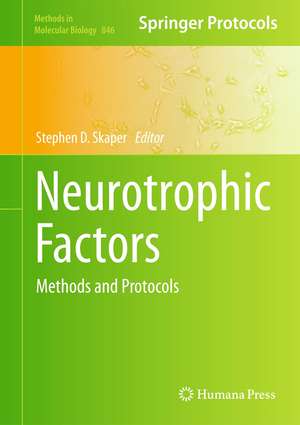Neurotrophic Factors: Methods and Protocols: Methods in Molecular Biology, cartea 846
Editat de Stephen D. Skaperen Limba Engleză Hardback – 25 feb 2012
Authoritative and easily accessible, Neurotrophic Factors: Methods and Protocols seeks to serve both professionals and novices alike with its well-honed methodologies in an effort to further our knowledge ofwhat has been described as the last frontier of science.
| Toate formatele și edițiile | Preț | Express |
|---|---|---|
| Paperback (2) | 598.82 lei 38-44 zile | |
| Springer – 5 sep 2018 | 598.82 lei 38-44 zile | |
| Humana Press Inc. – 23 aug 2016 | 896.34 lei 43-57 zile | |
| Hardback (2) | 659.70 lei 43-57 zile | |
| Humana Press Inc. – 25 feb 2012 | 659.70 lei 43-57 zile | |
| Springer – 9 dec 2017 | 966.15 lei 43-57 zile |
Din seria Methods in Molecular Biology
- 9%
 Preț: 791.59 lei
Preț: 791.59 lei - 23%
 Preț: 598.56 lei
Preț: 598.56 lei - 20%
 Preț: 882.95 lei
Preț: 882.95 lei -
 Preț: 252.04 lei
Preț: 252.04 lei - 5%
 Preț: 802.69 lei
Preț: 802.69 lei - 5%
 Preț: 729.61 lei
Preț: 729.61 lei - 5%
 Preț: 731.43 lei
Preț: 731.43 lei - 5%
 Preț: 741.30 lei
Preț: 741.30 lei - 5%
 Preț: 747.16 lei
Preț: 747.16 lei - 15%
 Preț: 663.45 lei
Preț: 663.45 lei - 18%
 Preț: 1025.34 lei
Preț: 1025.34 lei - 5%
 Preț: 734.57 lei
Preț: 734.57 lei - 18%
 Preț: 914.20 lei
Preț: 914.20 lei - 15%
 Preț: 664.61 lei
Preț: 664.61 lei - 15%
 Preț: 654.12 lei
Preț: 654.12 lei - 18%
 Preț: 1414.74 lei
Preț: 1414.74 lei - 5%
 Preț: 742.60 lei
Preț: 742.60 lei - 20%
 Preț: 821.63 lei
Preț: 821.63 lei - 18%
 Preț: 972.30 lei
Preț: 972.30 lei - 15%
 Preț: 660.49 lei
Preț: 660.49 lei - 5%
 Preț: 738.41 lei
Preț: 738.41 lei - 18%
 Preț: 984.92 lei
Preț: 984.92 lei - 5%
 Preț: 733.29 lei
Preț: 733.29 lei -
 Preț: 392.58 lei
Preț: 392.58 lei - 5%
 Preț: 746.26 lei
Preț: 746.26 lei - 18%
 Preț: 962.66 lei
Preț: 962.66 lei - 23%
 Preț: 860.21 lei
Preț: 860.21 lei - 15%
 Preț: 652.64 lei
Preț: 652.64 lei - 5%
 Preț: 1055.50 lei
Preț: 1055.50 lei - 23%
 Preț: 883.85 lei
Preț: 883.85 lei - 19%
 Preț: 491.88 lei
Preț: 491.88 lei - 5%
 Preț: 1038.84 lei
Preț: 1038.84 lei - 5%
 Preț: 524.15 lei
Preț: 524.15 lei - 18%
 Preț: 2122.34 lei
Preț: 2122.34 lei - 5%
 Preț: 1299.23 lei
Preț: 1299.23 lei - 5%
 Preț: 1339.10 lei
Preț: 1339.10 lei - 18%
 Preț: 1390.26 lei
Preț: 1390.26 lei - 18%
 Preț: 1395.63 lei
Preț: 1395.63 lei - 18%
 Preț: 1129.65 lei
Preț: 1129.65 lei - 18%
 Preț: 1408.26 lei
Preț: 1408.26 lei - 18%
 Preț: 1124.92 lei
Preț: 1124.92 lei - 18%
 Preț: 966.27 lei
Preț: 966.27 lei - 5%
 Preț: 1299.99 lei
Preț: 1299.99 lei - 5%
 Preț: 1108.51 lei
Preț: 1108.51 lei - 5%
 Preț: 983.72 lei
Preț: 983.72 lei - 5%
 Preț: 728.16 lei
Preț: 728.16 lei - 18%
 Preț: 1118.62 lei
Preț: 1118.62 lei - 18%
 Preț: 955.25 lei
Preț: 955.25 lei - 5%
 Preț: 1035.60 lei
Preț: 1035.60 lei - 18%
 Preț: 1400.35 lei
Preț: 1400.35 lei
Preț: 659.70 lei
Preț vechi: 776.13 lei
-15% Nou
Puncte Express: 990
Preț estimativ în valută:
126.23€ • 132.15$ • 104.45£
126.23€ • 132.15$ • 104.45£
Carte tipărită la comandă
Livrare economică 07-21 aprilie
Preluare comenzi: 021 569.72.76
Specificații
ISBN-13: 9781617795350
ISBN-10: 1617795356
Pagini: 400
Ilustrații: XIV, 421 p.
Dimensiuni: 178 x 254 x 30 mm
Greutate: 0.95 kg
Ediția:2012
Editura: Humana Press Inc.
Colecția Humana
Seria Methods in Molecular Biology
Locul publicării:Totowa, NJ, United States
ISBN-10: 1617795356
Pagini: 400
Ilustrații: XIV, 421 p.
Dimensiuni: 178 x 254 x 30 mm
Greutate: 0.95 kg
Ediția:2012
Editura: Humana Press Inc.
Colecția Humana
Seria Methods in Molecular Biology
Locul publicării:Totowa, NJ, United States
Public țintă
Professional/practitionerCuprins
The Neurotrophin Family of Neurotrophic Factors – An Overview.- Neuronal Growth-Promoting and Inhibiting Cues in Neuroprotection and Neurodegeneration.- Culture of Rat Cerebellar Granule Neurons and Application to Identify Neuroprotective Agents.- Isolation and Culture of Neural Progenitor Cells from Rat Postnatal Cerebellum.- Culture of Rodent Cortical and Hippocampal Neurons.- Amyloid β-Peptide Neurotoxicity Assay Using Cultured Rat Cortical Neurons.- Culture of Neonatal Rodent Microglia, Astrocytes, and Oligodendrocytes from Cortex and Spinal Cord.- Central Nervous System Neuron-Glia Co-Culture Models.- Culture and Characterization of Rat Mesencephalic Dopaminergic Neurons.- Preparation of Adult Spinal Cord Motor Neuron Cultures Under Serum-Free Conditions.- Rodent Retinal Ganglion Cell Cultures.- Culture of Purified Glial Cell Populations from Optic Nerve.- Isolation and Culture of Rat Cone Photoreceptor Cells.- Rat Retina Pigmented Epithelial Cells.- Mammalian Growth Cone Turning Assays Identify Distinct Cell Signalling Mechanisms that Underlie Axon Growth, Guidance and Regeneration.- Culture of Dissociated Sensory Neurons from Dorsal Root Ganglia of Postnatal and Adult Rats.- Culture and Proliferation of Highly Purified Adult Schwann Cells from Rat, Dog, and Man.- Use of PC12 Cells and Rat Superior Cervical Ganglion Sympathetic Neurons as Models for Neuroprotective Assays Relevant to Parkinson’s Disease.- Compartmented Chambers for Studying Neurotrophic Factor Action.- Preparation and Culture of Adrenal Chromaffin Cells.- Indirect Immunofluorescence Staining of Cultured Neural Cells.- Neurite Outgrowth Assessment Using High Content Analysis Methodology.- Dissociated Cell Culture for Testing Effects of Carbon Nanotubes on Neuronal Growth.- High-Resolution Imaging and Evaluation of Spines in Organotypic Hippocampal Slice Cultures.- Imaging Amyloid Precursor Protein In Vivo – An Axonal Transport Assay.- The Use of Specific AAV Serotypes to StablyTransduce Primary CNS Neuron Cultures.- Preparation and Characterization of Biocompatible Chitosan Nanoparticles for Targeted Brain Delivery of Peptides.- [3H]Serotonin Release Assay Using Antigen-Stimulated Rat Peritoneal Mast Cells.- Rat Hippocampal Slice Culture Models for the Evaluation of Neuroprotective Agents.- A 6-Hydroxydopamine In Vivo Model of Parkinson’s Disease.- Brain Microdialysis in Freely Moving Animals.- Evaluating Motor Neuron Death in Neonatal Rats Subjected to Sciatic Nerve Lesion.- Rodent Spinal Cord Injury Model and Application of Neurotrophic Factors for Neuroprotection.
Recenzii
From the reviews:
“It provides a foundation for neurobiological research into the effects of neurotrophic factors and other chemicals on the nervous system. … The audience is broad, including practicing and in training neuroscientists, neurobiologists, and basic neuroscience researchers in human and veterinary medicine, as well as academic neurologists, neurosurgeons, and pharmacists. The methods can be incorporated into basic research laboratories and into medical, biology, and veterinary classes.” (Ramsis Farid Ghaly, Doody’s Book Reviews, July, 2012)
“It provides a foundation for neurobiological research into the effects of neurotrophic factors and other chemicals on the nervous system. … The audience is broad, including practicing and in training neuroscientists, neurobiologists, and basic neuroscience researchers in human and veterinary medicine, as well as academic neurologists, neurosurgeons, and pharmacists. The methods can be incorporated into basic research laboratories and into medical, biology, and veterinary classes.” (Ramsis Farid Ghaly, Doody’s Book Reviews, July, 2012)
Textul de pe ultima copertă
Nervous system development evolves from the well-orchestrated processes of neural induction, cell proliferation, differentiation, cell migration, survival, and synapse formation. Among these environmental cues, neurotrophic factors are secreted proteins that promote neurite outgrowth, neuronal cell differentiation and survival both in vivo and in vitro. Nerve growth factor (NGF) is the founding and best characterized member of the neurotrophin family of neurotrophic polypeptides. Neurotrophic Factors: Methods and Protocols presents a selection of protocols and procedures which make use of cellular, tissue, and whole animal models which can be applied to the investigation of neurotrophic factors and other agents impacting on these systems. Chapters cover a wide-range of topics such as dealing with the culture of neurons and glia from the central and peripheral nervous systems, neuron-glia co-culture models, and cell-based assays for the evaluation of neuroprotective molecules, as well as assays which can be applied to the study of agents with neuroregenerative potential. Protocols describing viral- and nanoparticle-based delivery methods to neural cells are also presented, following by chapters dealing with organotypic slice culture protocols. Lastly, several chapters are dedicated to in vivo lesion models of relevance to nervous system pathology, which can be applied to the investigation of neurotrophic factors and peptides. Written in the successful Methods in Molecular Biology™ series format, chapters include introductions to their respective topics, lists of the necessary materials and reagents, step-by-step, readily reproducible protocols, and notes on troubleshooting and avoiding known pitfalls.
Authoritative and easily accessible, Neurotrophic Factors: Methods and Protocols seeks to serve both professionals and novices alike with its well-honed methodologies in an effort to further our knowledge ofwhat has been described as the last frontier of science.
Authoritative and easily accessible, Neurotrophic Factors: Methods and Protocols seeks to serve both professionals and novices alike with its well-honed methodologies in an effort to further our knowledge ofwhat has been described as the last frontier of science.
Caracteristici
Includes cutting-edge methods and protocols Provides step-by-step detail essential for reproducible results Contains key notes and implementation advice from the experts
















